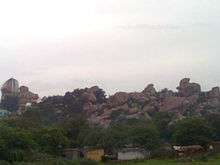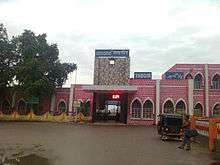Yadagiri
Yadgir is a city and the administrative headquarters of Yadgir district in the Indian state of Karnataka. It is also the administrative headquarters of Yadgir Taluku, one of the three talukas of the district.
Yadgir | |
|---|---|
city | |
 Yadgir Location in Karnataka, India | |
| Coordinates: 16.77°N 77.13°E | |
| Country | |
| State | Karnataka |
| Region | ಕಲ್ಯಾಣ ಕರ್ಣಾಟಕ Kalyana-Karnataka |
| District | Yadgir district |
| Lok Sabha Constituency | Raichur (Lok Sabha constituency) |
| Area | |
| • Total | 5.6 km2 (2.2 sq mi) |
| Elevation | 389 m (1,276 ft) |
| Population (2011)[1] | |
| • Total | 74,294 |
| • Density | 10,500.36/km2 (27,195.8/sq mi) |
| Languages | |
| • Official | Kannada |
| Time zone | UTC+5:30 (IST) |
| PIN | 585201 / 585202 |
| Telephone code | 08473 |
| Vehicle registration | KA-33 |
| Website | www.yadgircity.mrc.gov.in |
Geography
Yadagiri town covers an area of 5.6 square kilometres (2.2 sq mi).[2] The Bhima River flows through the town.
Overview
Yadagiri, historically known as Yetagiri,[3] is dotted with many historical monuments and has a hill fort with three rounds of fortifications. There are three ancient temples, medieval mosques, tanks and wells on top of the hill. A pond, the Sanna Kere is located in the heart of the town.[4]
Demographics
In 2011, Yadagiri had a population of 1,172,985 of whom males were 591,104 and females 581,881 respectively. In the 2001 census, Yadagiri had a population of 956,180 of whom males were 482,347 and 473,933 were females. Yadagiri district's population constitutes 1.92 percent of the total population of Karnataka. In the 2001 census, this figure for Yadagiri district was at 1.81 percent.
There was a change of 22.67 percent in the population compared to the population as per the 2001 census. In the census of 2001, Yadagiri district recorded an increase of 20.12 percent to its population compared to 1991.
The initial provisional data released by census India 2011 shows that the density of Yadagiri district for 2011 is 224 people per km2. In 2001, Yadagiri district's density was 183 people per km2. Yadagiri district covers an area of 5,225 sq. kms.
Average literacy rate of Yadagiri in 2011 was 52.36, compared to 39.90 in 2001. Male and female literacy were 63.33 and 41.31 respectively. In the 2001 census, the same figures stood at 51.35 and 28.32. The total number of literates in Yadagiri district was 516,940, of whom male and female were 313,797 and 203,143 respectively.

Culture and Religion

In Yadagiri, there are many spiritual places, e.g., Mayllapur Mallayya. The temple of Shree Kshetra Mouneshwara in Tinthani in Shorapur Taluka attracts more than 100,000 devotees every year. In Gurmitkal is situated the famous Mata Manikeshwari temple. The sofi sarmast durga is in the village of Sagar in the Shahapur taluka. The durga attracts thousands of people in the urus. Darga Shah Jeewan Shah is located near the Gunj area of Yadagiri.
Irrigation
Agriculture in the district is mainly rainfed. The net area irrigated to the net area sown is 38%, which is above the state average of 24%. Krishna, Bhima and Dhoni rivers flow through the district. The irrigation projects in the district are Hattikuni and Soudagar. There are 36 lift irrigation schemes and 445 minor irrigation tanks in the district.
History
The town was part of the empire of the Western Chalukyas from the 10th to the 12th centuries. The name Yadagiri (historically Yetagiri[3]) is derived from its early medieval rulers, the 'Yadavas'. Their establishments were on a hill ('giri' in Kannada means hill). Major economic development of the city took place under Philip Meadows Taylor, the British administrator of the principality of Shorapur.
Transport
Yadagiri is connected by road and rail.

- Railway
Yadagiri has a broad gauge railway station, Yadgir railway station[6], and lies between Mumbai and Chennai. It comes under the South Central Railway under the Guntakal division. The city is connected to Gulbarga, 78 kms. away by rail and 84 kms. away by road. From Raichur, its distance is 81 kms. It is located between the two districts - Gulbarga and Raichur.[7]
- Road
State Highway 15 passes through the city connecting the city to Bijapur and Hyderabad. Important cities connected through buses to the city are Bengaluru, Hubballi, Dhaaruwaada, Bellagaavi, Shirasi, Hosapete, Vasco da Gama in Goa, Hyderabad, Ballari, Raichur.[8]
Industry
Yadagiri is full of natural resources. Two rivers flow through Yadagiri, the Krishna and the Bhima. There is a lot of scope for industrialization. A sugar factory and a fuel factory, "Core Green" are established near Hiretumkur village.[9] Recently, rich uranium deposits have been found in the Gogi belt, covering the villages of Gogi, Ukkinal & Darshanapur in Shahapur taluk and Thinthini & other places in Surapur taluk. Uranium mined and processed here will be used for defense and power generation purposes.
References
- http://www.censusindia.gov.in/pca/SearchDetails.aspx?Id=666255
- "Population of Corporation/CMC/TMC/TP: Population 2001 Census". Directorate of Municipal Administration, Government of Karnataka. Archived from the original on 10 April 2009.
- "A strong hold on the past". Retrieved 7 January 2011.
- Naraboli, Ravikumar (5 June 2016). "Lumbini Park in Yadgir is a picture of neglect". The Hindu. ISSN 0971-751X. Retrieved 10 December 2019.
- http://www.census2011.co.in/census/district/270-yadgir.html
- "Yadgir District Map Showing Railway Line". Yadgir District.
- "Yadgir railway station plays it cool". www.thehindu.com. Retrieved 8 October 2017.
- "NEKRTC Yadgir Division". www.nekrtc.com. Retrieved 8 October 2017.
- Srinivas Sirnoorkar (13 May 2010). "India's third uranium mining unit at Gogi". Deccan Herald.